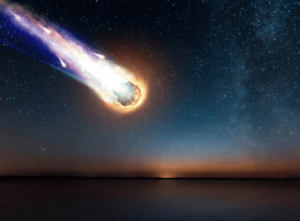
별똥별 현상은 빠르게 움직이는 작은 입자들(유성체로 알려진)이 지구의 대기와 충돌하면서 발생합니다. 유성체가 지구 대기권에 진입할 때, 그것은 유성 또는 별똥별이라고 불립니다. 이 현상의 기본 원리는 다음과 같습니다.
- 유성체: 유성체는 암석, 금속 또는 물질의 조합으로 만들어질 수 있는 작고 단단한 입자입니다. 그것들의 크기는 작은 먼지 알갱이에서부터 큰 바위에 이르기까지 다양하며 혜성이나 소행성의 잔해로 여겨집니다.
- 대기 진입: 유성체가 지구 대기권에 진입하면 공기 분자와의 마찰로 인해 뜨거워지기 시작합니다. 이로 인해 유성체는 백열 상태가 되어 밝은 빛의 흔적을 만들어내는데, 이 흔적은 지상에서 별똥별처럼 보이게 됩니다.
- 단자 속도: 유성체가 지구 대기권을 통과하면서 낙하하면서 대기의 항력으로 인해 도달할 수 있는 최대 속도인 말단 속도에 도달합니다. 말단 속도는 대기의 밀도뿐만 아니라 유성체의 크기와 구성에 따라 달라집니다.
- 유성 궤적: 유성체가 떨어지면서, 그것은 유성 흔적으로 알려진 이온화된 가스의 흔적을 남기게 됩니다. 유성 흔적은 유성이 지나간 후 짧은 시간 동안 볼 수 있으며, 몇 초에서 몇 분까지 지속될 수 있습니다.
- 유성우: 유성우는 지구가 혜성의 궤도를 통과할 때 발생해 많은 수의 유성체가 동시에 지구 대기권으로 진입하게 됩니다. 유성우가 내리는 동안 보이는 별똥별의 수가 크게 늘어나 밤하늘에 장관을 연출할 수 있습니다.
- 운석: 만약 운석이 지구의 대기를 통과할 때까지 생존할 수 있을 만큼 충분히 크다면, 그것은 땅에 닿아서 운석이 될 수 있습니다. 운석은 태양계의 기원에 대한 귀중한 정보를 제공할 수 있는 귀중한 과학적 표본입니다.
- 운석 충돌: 운석 충돌은 지구에 상당한 영향을 미칠 수 있으며, 가장 큰 운석 충돌 중 일부는 대멸종과 다른 중요한 지질학적 사건과 관련이 있습니다. 어떤 경우에는 운석 충돌로 인해 애리조나의 배링거 유성 분화구와 같은 큰 분화구가 형성되기도 합니다.
이것은 유성체가 지구의 대기와 충돌할 때 발생하는 매혹적인 현상인 별똥별의 원리에 대한 간단한 설명이었습니다.